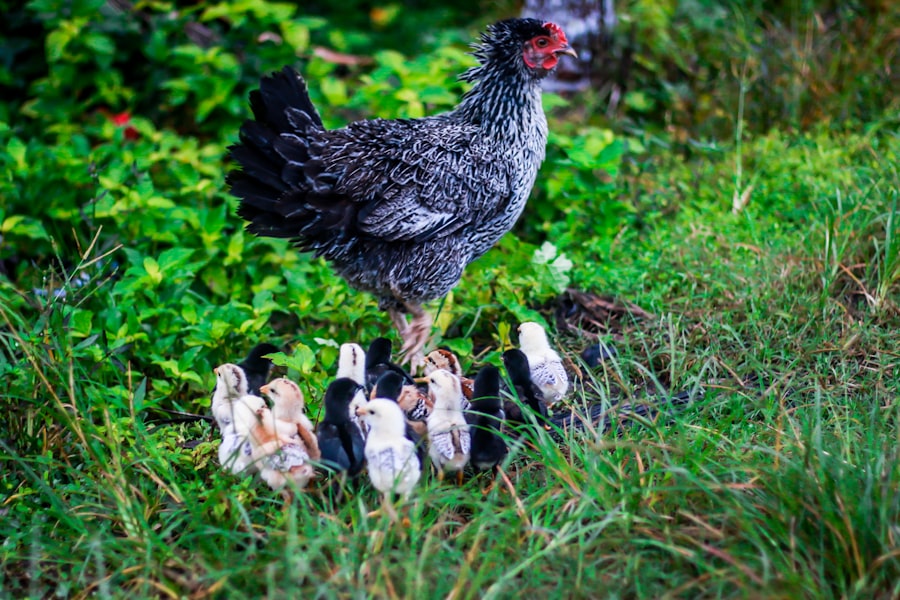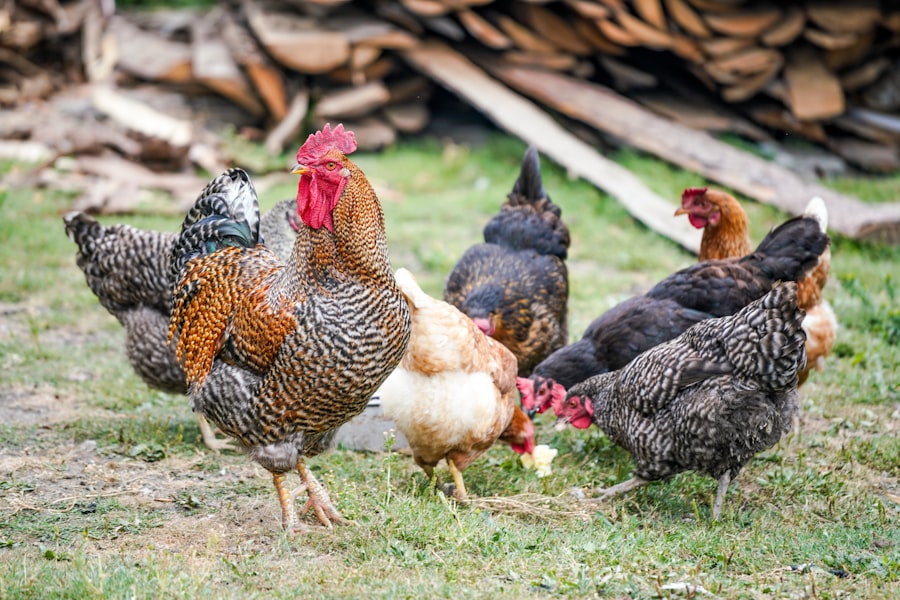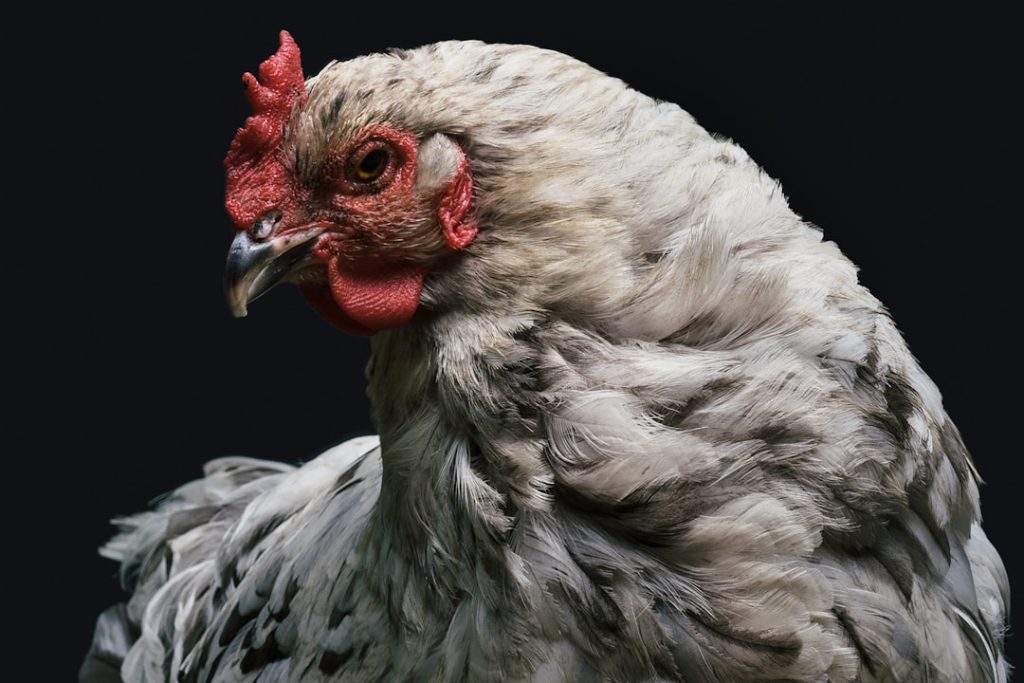Chickens are naturally curious and social animals with a strong instinct to roost in elevated areas at night for protection from predators. They are creatures of habit, typically returning to the same roosting spots each evening. Understanding these behaviors is essential for developing effective solutions to prevent chickens from roosting in undesired locations.
Chickens maintain a hierarchical social structure within their flock, which can influence their roosting preferences. Observing their behavior and comprehending their social dynamics can help identify the reasons behind their roosting choices, allowing for more targeted interventions. Chickens are also sensitive to environmental changes, so any modifications to their roosting area should be implemented gradually to minimize stress and resistance.
A thorough understanding of chicken behavior is crucial for effectively addressing roosting issues. By considering their natural instincts, social structure, and environmental sensitivities, poultry keepers can develop more successful strategies to manage roosting habits and maintain a healthy, well-organized flock.
Table of Contents
- 1 Implementing Physical Barriers
- 2 Using Deterrents and Repellents
- 3 Providing Alternative Roosting Options
- 4 Creating a Distraction
- 5 Training and Conditioning
- 6 Seeking Professional Advice
- 7 FAQs
- 7.1 What are some effective methods for keeping chickens off shelves?
- 7.2 Why is it important to keep chickens off shelves?
- 7.3 Are there any natural deterrents that can be used to keep chickens off shelves?
- 7.4 What are some considerations to keep in mind when trying to keep chickens off shelves?
- 7.5 Are there any legal or ethical considerations to keep in mind when implementing methods to keep chickens off shelves?
Key Takeaways
- Chickens are naturally curious and will explore their surroundings, so understanding their behavior is key to preventing them from roosting in unwanted areas.
- Implementing physical barriers such as fences, netting, or covers can effectively prevent chickens from roosting in specific areas.
- Using deterrents and repellents such as motion-activated lights, noise machines, or predator decoys can discourage chickens from roosting in certain spots.
- Providing alternative roosting options such as designated perches or roosting bars can redirect chickens to more suitable areas.
- Creating a distraction with toys, treats, or other stimuli can divert chickens’ attention away from unwanted roosting spots.
- Training and conditioning chickens through positive reinforcement can help them learn to roost in designated areas.
- Seeking professional advice from a veterinarian or animal behaviorist can provide additional insights and strategies for managing chicken roosting behavior.
Implementing Physical Barriers
Blocking Access to Undesirable Roosting Spots
One effective way to prevent chickens from roosting in unwanted areas is by implementing physical barriers. This can include installing wire mesh or netting to block off access to certain roosting spots, or using barriers such as fences or partitions to redirect chickens to designated roosting areas. By physically preventing chickens from accessing undesirable roosting locations, you can effectively control their behavior and encourage them to roost in more suitable areas.
Ensuring the Effectiveness of Physical Barriers
It’s important to ensure that any physical barriers are secure and well-constructed to prevent chickens from bypassing them. Regular maintenance and inspection of these barriers are also crucial to address any potential weaknesses or damages that may compromise their effectiveness.
Considering Chicken Comfort and Safety
Additionally, it’s important to consider the comfort and safety of the chickens when implementing physical barriers, ensuring that they have access to suitable roosting areas that meet their needs.
A Effective Solution for Roosting Control
Overall, physical barriers can be an effective solution for deterring chickens from roosting in unwanted areas.
Using Deterrents and Repellents

In addition to physical barriers, using deterrents and repellents can also be an effective strategy for preventing chickens from roosting in undesirable locations. There are various commercial products available that are specifically designed to deter chickens, such as sprays or powders with strong scents or tastes that are unpleasant to chickens. These products can be applied to surfaces or areas where chickens tend to roost, effectively discouraging them from returning to those spots.
Natural deterrents such as citrus peels, garlic, or chili peppers can also be used to create unpleasant odors or tastes that repel chickens. These natural remedies are safe and non-toxic, making them a suitable option for deterring chickens without causing harm to them or the environment. It’s important to regularly reapply these deterrents to maintain their effectiveness, especially after rainfall or when exposed to outdoor elements.
It’s important to note that while deterrents and repellents can be effective in the short term, they may not provide a long-term solution to roosting issues. Chickens may become accustomed to certain scents or tastes over time, reducing the effectiveness of these methods. Therefore, it’s important to combine deterrents and repellents with other strategies for a comprehensive approach to addressing roosting problems.
Providing Alternative Roosting Options
Another approach to preventing chickens from roosting in unwanted areas is by providing alternative roosting options that meet their natural instincts and preferences. This can include installing designated roosting poles or platforms in suitable locations within the coop or outdoor area. By providing comfortable and secure roosting options, you can encourage chickens to choose these designated spots over undesirable locations.
It’s important to consider the size and design of the roosting options to accommodate the specific needs of the chicken flock. Roosting poles should be wide enough for chickens to comfortably perch on and positioned at an appropriate height to mimic their natural roosting habits. Additionally, providing multiple roosting options can help distribute the flock and reduce competition for space, minimizing the likelihood of overcrowding or disputes among the chickens.
Regular cleaning and maintenance of the roosting areas are also essential to ensure a clean and hygienic environment for the chickens. By providing suitable alternative roosting options, you can effectively redirect the chickens’ behavior and discourage them from roosting in unwanted areas.
Creating a Distraction
Creating distractions can also be an effective strategy for preventing chickens from roosting in undesirable locations. By introducing new elements or activities in the coop or outdoor area, you can divert the chickens’ attention and encourage them to engage in alternative behaviors instead of roosting in unwanted spots. This can include introducing new toys or objects for the chickens to explore, as well as providing enrichment activities such as foraging opportunities or interactive feeders.
By creating a stimulating and engaging environment, you can reduce the likelihood of chickens becoming fixated on specific roosting spots and encourage them to explore other areas within their living space. It’s important to regularly rotate and update the distractions to maintain their effectiveness and prevent habituation among the chickens. Additionally, providing ample space for the chickens to move around and engage in natural behaviors such as scratching, dust bathing, and pecking can help reduce boredom and prevent them from seeking out undesirable roosting locations out of habit or frustration.
Overall, creating distractions can be a valuable strategy for managing chicken behavior and preventing roosting issues.
Training and Conditioning

Positive Reinforcement Techniques
By using positive reinforcement techniques, you can reward desirable behaviors such as using designated roosting spots or responding to cues for alternative activities. Consistently rewarding and reinforcing these behaviors encourages the chickens to develop new habits and preferences that align with your desired outcomes.
Key Considerations for Effective Training
It’s essential to be patient and consistent when implementing training and conditioning methods, as it may take time for the chickens to learn and adapt to new behaviors. Using treats, praise, or other rewards that are highly motivating for the chickens can help reinforce the desired behaviors and make the training process more effective.
Avoiding Negative Consequences
Avoid using punishment or aversive techniques that may cause stress or fear in the chickens, as this can have negative effects on their well-being and behavior. Instead, focus on positive reinforcement and creating a supportive learning environment that encourages the chickens to engage in desired behaviors.
Seeking Professional Advice
If you’re struggling with persistent roosting issues despite implementing various strategies, seeking professional advice from a veterinarian, animal behaviorist, or experienced poultry specialist can provide valuable insights and guidance. These professionals can assess the specific factors contributing to the roosting problems and offer tailored recommendations for addressing them effectively. A professional assessment can help identify any underlying health issues, environmental stressors, or social dynamics within the chicken flock that may be influencing their roosting behavior.
By addressing these underlying factors, you can develop a more targeted approach to managing roosting issues and promoting positive behavior among the chickens. Additionally, professionals can provide expert guidance on best practices for managing chicken behavior, optimizing their living environment, and promoting their overall well-being. This can include recommendations for coop design, environmental enrichment, social dynamics within the flock, and other factors that may impact chicken behavior.
Overall, seeking professional advice can provide valuable support and expertise in addressing roosting issues and promoting positive behavior among your chicken flock. By collaborating with knowledgeable professionals, you can develop a comprehensive strategy for managing chicken behavior and creating a harmonious living environment for your feathered friends.
If you’re looking for tips on how to keep chickens off shelves, you might also be interested in learning about the importance of a well-designed chicken coop. Check out this article on farmhouse chicken coop to discover how a properly constructed coop can provide a safe and comfortable environment for your chickens, ultimately helping to prevent them from wandering onto shelves and other unwanted areas.
FAQs
What are some effective methods for keeping chickens off shelves?
Some effective methods for keeping chickens off shelves include using physical barriers such as wire mesh or netting, using deterrents such as motion-activated sprinklers or noise-making devices, and providing alternative roosting or perching areas for the chickens.
Why is it important to keep chickens off shelves?
It is important to keep chickens off shelves to prevent damage to the items on the shelves, maintain cleanliness and hygiene in the area, and ensure the safety of both the chickens and the items on the shelves.
Are there any natural deterrents that can be used to keep chickens off shelves?
Yes, there are natural deterrents that can be used to keep chickens off shelves, such as citrus peels, vinegar, or strong-smelling herbs like lavender or mint. Chickens generally dislike these scents and will avoid areas where they are present.
What are some considerations to keep in mind when trying to keep chickens off shelves?
When trying to keep chickens off shelves, it is important to consider the behavior and habits of the chickens, the layout and design of the shelves, and the potential impact of any deterrents or barriers on the chickens’ overall well-being and comfort.
Are there any legal or ethical considerations to keep in mind when implementing methods to keep chickens off shelves?
Yes, there may be legal and ethical considerations to keep in mind when implementing methods to keep chickens off shelves. It is important to ensure that any methods used are humane and do not cause unnecessary harm or distress to the chickens. Additionally, local regulations or ordinances regarding the keeping of chickens should be taken into account.
Meet Walter, the feathered-friend fanatic of Florida! Nestled in the sunshine state, Walter struts through life with his feathered companions, clucking his way to happiness. With a coop that’s fancier than a five-star hotel, he’s the Don Juan of the chicken world. When he’s not teaching his hens to do the cha-cha, you’ll find him in a heated debate with his prized rooster, Sir Clucks-a-Lot. Walter’s poultry passion is no yolk; he’s the sunny-side-up guy you never knew you needed in your flock of friends!







